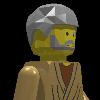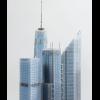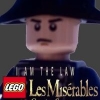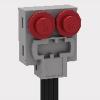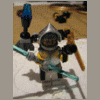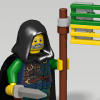Search the Community
Showing results for tags 'architecture'.
Found 375 results
-
Update: for an updated version, please scroll down ----------------------------------------------------------------- Ancient Greece has always fascinated me. I studied their language in high school, and this year I visited Greece itself. And although I've been fond of their architecture since a long time, I was impressed by everything I saw there . People say that Greece is just a pile of ancient rocks . But I say that pile of rocks is quite a sight . This inspired me to build some columns in Lego. The Dorian order is very typical for Greece, but not much of a challenge for Lego . I had a go at the Ionian order, but that turned out way too big. Spirals are really hard to do. I was left with the Corinthian order. Although not the most typical for Ancient Greece, the design fascinates me. With the acanthus-leaves, it looks like a tree. It makes temples look like an extention of nature. Not a better thing to do if you want to provoce the super-natural, the divine. [MOC] Corinthian column - capital by Bert.VR, on Flickr So this is what I came up with. The model consists of 412 bricks. _________ [MOC] Corinthian column by Bert.VR, on Flickr______[MOC] Corinthian column - exploded by Bert.VR, on Flickr I wanted to make it more or less in minifig scale, and I think I managed that . The tooth pieces (part ID 49668) made nice leaves, and the rest followed. The problem was fitting as many as possible in a small space. The eight-bar-rings (part ID 75937) prooved to be pretty handy. I used three of them in the capital, and one in the base. It really is the heart of this model. The actual column was rather hard to make. The technique from the Lego website made a column with eight tiles forming a cilinder. That was too small. I ended up with twelve tiles, connected by the cross/steering wheel/winch handle/I-don't-know-what-to-call-it-piece (to make things simple: part ID 48723). It turned out quite well, although I have some minor doubts concerning the strength of the construction. I'm not too happy with the base , but that's not the main focus, and perhaps the pillar should be a little longer. But that shouldn't be too hard to change, and it had to fit on the picture anyway. [MOC] Corinthian column - base by Bert.VR, on Flickr So despite its flaws, I hope you like it. This design could be used in numerous Greek or Roman builds, and I made sure there were studs on the top and on the bottom to connect it. I hope you get inspired...
-
SVERDLOVSK '86 In 1986, the confrontation between the two superpowers reached its climax and turned into the third world war. Nuclear strike razed to the ground dozens of major cities on the continents turning them into a lifeless desert. Millions of tons of radioactive dust raised into the air by the powerful explosions that led to large-scale environmental disaster. The remnants of humanity were thrown back in the development for centuries, and leading a losing battle for survival. Spiral of evolution on Earth has completed its turn and start a new one ... One of the places where you can meet the survivors became Sverdlovsk. This city with a million people was once the main administrative, industrial and cultural center of the Urals. Perhaps being in the interior of the continent away from the object of the main attack saved it. SVERDLOVSK by vir-a-cocha, on Flickr A handful of survivors settled on the right bank of the dry river Iset in the former building of the circus. The unique design of the dome withstood the shock wave. A second preserved building is unfinished TV Tower maden from the heavy-duty concrete. It was not finished in time of peace, and construction stopped at around 219m. SVERDLOVSKby vir-a-cocha, on Flickr Now, it's just concrete structures buried under the dust . The right bank of the Iset River, between the streets of Kuybysheva, 8-go Marta and the Dekabristov, and all the buildings are made in the scale of 1:2000. (geotaged) SVERDLOVSK by vir-a-cocha, on Flickr Somewhere in another reality ... In 1986, a meeting of Gorbachev and Reagan in Reykjavik, which marked the beginning of a new foreign policy of the USSR. From this moment the relations between the countries have warmed. In Soviet Union Perestroika has began, then another serie of events occured during which the Soviet Union ceases to exist. Sverdlovsk in 1991, was renamed into Ekaterinburg. Circus, located on the corner of Kuibysheva Str and March 8 Str, continues to delight children and their parents. The famous TV tower was never completed. After 1989 began construction financing shortages, and it was frozen. In 90s the tower was a popular place for suicides, adventurers, climbers and BASE jumpers. After a series of resonant accidents access to it was closed. Video aerial view shows the beauty of the center of modern Ekaterinburg. youtu.be/PoWjtfDNAB0
- 1 reply
-
- Microscale
- Architecture
-
(and 2 more)
Tagged with:
-
Hi all, I would like to show you my latest creation, the Flower Box. When you hear the florist, what do you think? A shop stuffed with flowers? Since the opening of my studio Box N, they have been working on different projects and finally the first commission for them is completed. I don't explain much as my presentation board will tell you the design story behind the iconic building! Flower Box by niteangel, on Flickr Flower Box by niteangel, on Flickr Flower Box by niteangel, on Flickr Flower Box by niteangel, on Flickr Flower Box by niteangel, on Flickr Flower Box by niteangel, on Flickr Flower Box by niteangel, on Flickr Flower Box by niteangel, on Flickr Visit the Flickr album for a little more images! Do you enjoy the new modern architecture in my V City? Thanks!
- 20 replies
-
- flower box
- florist
-
(and 6 more)
Tagged with:
-
Hello everyone, What is this mysterious LEGO Architecture package? Read on to find out! Revealing the latest 21021 Marina Bay Sands Architecture Set I am really very pleased to bring this exclusive new review to our Eurobricks Community. Special thanks to The LEGO Group (TLG) and Eurobricks Staff/LEGO Ambassador, CopMike for facilitating and giving me this exclusive opportunity to review this superb new LEGO Architecture set! Before I was given this chance to review, I was determined to buy this set as soon as it is available locally, so I can also do a review of this new iconic architecture that is the first international feature of my country, Singapore. Without further ado, let's bring you a tour of this newly acclaimed building structure. Before I begin in proper, some of you is wondering why the first two opening images look particularly unique as compared with the mainstream release. It is because this is a special edition for very special release for publicity purpose and it will not be available at retail front. The content is the same but the packaging is very different. Other than that, the main focus is the LEGO set itself. Name: 21021 Marina Bay Sands (Republic of Singapore) Theme: LEGO Model Making / Architecture Year: 2014 Pieces: 602 Minifigs: 0 minifigure Price: USD N.A, GBP N.A, EURO N.A, SGD $89.90 Resources: Brickset, BrickLink An original box image of the 21021 Marina Bay Sands (Republic of Singapore) Back view of the original box image of the 21021 Marina Bay Sands (Republic of Singapore) By seeing the front and back of this box image, has certainly impressed me very much. The packaging for the LEGO Architecture products is very remarkable and is of the usual high standard that we have seen earlier. There are lots of details that can be found in the front and back. At one easy glance, you could have realised that this building, Marina Bay Sands is designed by the famous architect, Moshe Safdie. The box even reflect his signature. This iconic building landmark is designed by the LEGO Architectural Artist, Rok Zagalin Kobe. His name can be found at the front of the box, located at the bottom left hand corner. In this image, you will be able to view a very brief description touching on the Marina Bay Sands. Different side view of the original box image of the 21021, Image 1 Different side view of the original box image of the 21021, Image 2 Different side view of the original box image of the 21021, Image 3 Different side view of the original box image of the 21021, Image 4 The very first Singapore Landmark which is being featured by The LEGO Architecture Product Line The Marina Bay Sands is a state of the art modern day marvel, even with its bricks built design. Through the LEGO Architecture Series, TLG has officially iconise the first ever Singapore building landmark into the world of LEGO, which I am very proud to associate with. As you may have recall that there was a poll even though the poll link seem to be in non-existence, conducted by TLG, one of the choices was the Marina Bay Sands and I was very pleased that the choice that I have voted for, has actualised into a formal product offering in this series later this year. I was thrilled and elated by the results in early February 2013, when news that the Marina Bay Sands won the poll. The Marina Bay Sands is a model of a Singapore recent new landmark. The building is a hotel by itself, and is an integral part of the beautiful Singapore's city skyline which is mesmerising at day and night. The LEGO building model focuses on the signature hotel complex that showcases the three tall towers and the rooftop Sands Skypark. The building dimensions for the LEGO building model is measured at 224mm length and 136mm height. The official information for the Marina Bay Sands is as followed, first opened in 2010, the Marina Bay Sands is the leading business, leisure and entertainment destination in Asia. It features large and flexible convention and exhibition facilities, 2560 hotel rooms and suites, casino (one of its two in Singapore), the rooftop Sands Skypark, shopping mall, celebrity chief restaurants and an outdoor event plaza. Its two theatres showcase a range of leading entertainment performances including world-renowned Broadway shows. Completing the line-up of attractions is ArtScience Museum at Marina Bay Sands which play hosts to permanent and marquee exhibitions. You may visit the official website for more information. This 21021 Marina Bay Sands is marketed as Limited Edition. From my understanding, there is only 10,000 sets produced and is rumoured only to be exclusive for sales in Singapore. As of now, I can tell you that all of the local toy retailers and even the Marina Bay Sands gift shop is currently out of stock. Apparently, the first shipment had been wipe cleaned off the shelves and I am glad to manage to be able to grab a few before it is totally out of stock. I do believe that there will be a second shipment but I am not sure how or when it will ever appear again. Because I don't believe that all 10,000 sets had been wiped clean in Singapore 'for good' in this single shipment within less than two weeks of retail sales. I really hope there will be more stock appearing, because it will be a huge disappointment for many LEGO Architecture fans especially to our international friends. I also heard that the set is available in Hong Kong, and perhaps in other parts of Asia as well. I sure look forward to see more of these sets appearing in other places, than Singapore. Enjoy your building experience There is lots of hype and anticipation when I opened this! It look as if the packaging is communicating with me and it is definitely effective, when it convey such a simple message across to my mind. I will certainly enjoy this building experience that I have been waiting for. The content of the sealed box Within the sealed box, it comes with five packages and a beautiful instruction manual to build up the set. It also come with a single promotional leaflet which feature the recent LEGO Architecture highlights and a survey request by TLG. I will encourage you to do your part and send your feedback to this survey if you happen to buy the LEGO Architecture series. I am sure the LEGO Architecture design team is keen to find out your thoughts on your latest purchase. The construction materials As you can see from above, it is a good assortment of white and transparent blue bricks that form the main building structure, while the dark and light grey form the building foundation. Let's see how this building transform itself in LEGO bricks. I like the part, that the Marina Bay Sands is feature as a printed tile which is shown in the next image. The beginning of the construction of Marina Bay Sands Laying the building foundation The various dark grey flat tiles, mainly 2x4 size, are placed in a systematic manner that laid the foundation of this building structure. Front view of a single tower This building component form the main structure of a single tower. We will be repeating these steps for the other two towers as well and combined them shortly. As of now, it only show the half-completed tower of the front building. As you rotate to the back, you will see many of these white grids. These are the illustration of the hotel rooms balconies. The bottom of the walkway of the building show the connection of the base from one end to another. Back view of a single tower All of the three towers together ready to be constructed This is the back view of the building structure which depict the hotel rooms There are individual supporting layers within each towers We also need to create these three individual supporting layers that are meant to be placed within each towers to represent the different floors from within the towers. This is the design of the glass front of the building structure Now you add in the main design of the glass front onto the individual towers with numerous levels of transparent blue to show the glass levels accordingly. From the actual building design, I personally felt that this design is lacking of, is the gradual curves of the three towers. It is not as perfect as I hope it will be, but at one glance, people can still instantly recognise it as the Marina Bay Sands. Placing the glass windows onto the building front Building the top level of the building structure After completing the three towers, we will turn our attention to the top level that will be featuring the Sands Skypark and within the attraction, you will probably noticed the Infinity Swimming Pool from the top aerial view. It is amazing to swim in such a spectacular scenery which is 57 stories above ground floor and enjoying the Singapore's city skyline. Front view of the Marina Bay Sands Back view of the Marina Bay Sands Top view of the Marina Bay Sands This is the side entrance of the building It appears to be an exit shelter Black and White feature The base and the building structure can be removed as two distinct pieces Lining up the Marina Bay Sands building structure Some of the nice pictures of the real Marina Bay Sands The completed building can be kept safely into the original box At the end of the day by separating the two distinct pieces away, I will be able to keep this whole set nicely in the original nice packaging for storage. I wasn't feeling so well lately and I failed to take a good picture of the actual LEGO set with the scenery behind. I am planning to take a picture within the next few weeks! The weather was not very good lately due to the rainy season. Still, I will love to get an actual shot from my camera together with the completed built. I will keep all of you posted later on. To conclude, I am very pleased with this LEGO Architecture of the Marina Bay Sands. This deserved a very special place in my own collection, especially since this is my second LEGO Architecture set that I own, after the 21006 White House. I like how the designer capture the essence of this whole building design and present it in our favourite LEGO bricks. Even though the gradual curves are not captured perfectly for the three towers, but the overall appeal is very nicely done up and it made as a fine masterpiece to placed in a display cabinet. Not to mention, that I am proud to see a Singapore building landmark being made into my favourite toy hobby, LEGO and to showcase this icon to the global scene. I really wish to see more of other Singapore landmarks being able to capture in the LEGO Architecture series. Summary review Playability: 7/10 (LEGO Architecture sets can't played well with regular LEGO System sets because of the lack of the minifigures.) Design: 8.5/10 (The design is done up very nicely and it is almost perfect, minus the imperfection of the gradual curves for the towers.) Price: 7.5/10 (The set is a little pricey and furthermore with the 10,000 sets released worldwide, will expect the price to rose further in the secondary market.) Overall: 7.7/10 (Complete your LEGO Architecture series and don't give this set a miss, for Singapore fans, you ought to grab this iconic landmark by showing your support for it.) I gave it a "4" based on my Review Score Card. What about yours? I hope every one of you enjoyed reading this simple review of mine. Comments and Criticisms are strongly welcomed. Pictures can be found in My Flickr and My Brickshelf (When moderated)
- 83 replies
-
- Singapore
- Limited Edition
-
(and 2 more)
Tagged with:
-
Hello, and welcome to my review of the brand new Architecture Studio set, 21050 Create Your Own Architecture. First of all, I would like to thank The LEGO Group and all of those who are involved on Eurobricks who've made this review possible. This is a very exclusive set that has just been released in the United States (and is rumored to appear worldwide soon), and I'm sure many are curious to know the details. Well look no further, because this review will investigate this new set in-depth. Read on! Set: 21050 Create Your Own Architecture Theme: Architecture (Studio) Pieces: 1210 Minifigures: 0 Price: $149.99 USD Brickset Bricklink Catalog The Box The first thing to notice about this set is that the box is HUGE. Unlike most boxes, this one has square sides, which make it larger depth-wise. It is also sizable length- and height-wise. A few other things to note are the relatively large piece count and the age. 16+ years is the oldest recommended age I've seen on a set box, so that might hint at the nature of the set. However, the contents prove to be a mystery; I wasn't sure what to expect when the set first arrived. This may also be the case for the casual customer who would only glance at the box on the shelf in the store. The back of the box is much more helpful in determining what this set is all about, and provides a description as well as pictures. The lack of focus on the actual pieces or builds of the set may be of some interest here. Aha, so this is no traditional LEGO set. In reality, it's more of a beginners guide to Architecture and LEGO, which I will touch on more later in this review. This set can be compared to LEGO parts buckets, in that no real set design is given, but creativity and building your own creations with the parts given is encouraged. Here's a shot of the box from an angle, showing the proportions. Have I mentioned that it's huge? The top and bottom of the box depict inspirational models and production information. I'd like to highlight the note on the bottom of the set for a moment. The inspiration is all well and good, and encourages builders to combine these parts with the rest of their collection, but I find it a bit of a letdown to not be able to build these models with the pieces given. This occurs several other times in the process of exploring this set. The sides of the box show the parts listing (which is fairly uncommon in my experience) as well as all of the contents spilled out and sorted. Opening the box was a bit of a challenge since there were no punch-holes or flaps. The only way to open it would be to rip the cardboard partially, which is what I had to do. I imagine the reason for this design would be to prevent theft, but the box would have been nice for storage because of its shape and volume. The Contents: Moving on to the actual contents of this set, the first thing to slide out is a pair of clear sorting trays, which will be used to hold some of the parts. I'm not sure if these are new, but they sure are neat, and would be helpful for sorting parts of any collection. The plastic tray is also an "official" LEGO part, so I challenge MOCers to incorporate it somehow into their creations. Next up is a small double-sided slip of paper advertising a survey that allows entry for a raffle for the Fransworth House set. Both sides are the same except for the language. These things were used to protect the contents from getting damaged in the box, but they can also be used for holding pieces. Innovative! Next come the bags of parts, and there are a lot of them. I'll go into more detail later on. And finally, the true focus of the set: the booklet. It comes in a protective cardboard case that, like the other cardboard trays, doubles as a place to put parts. The Pieces: Before we head into the booklet, I would like to show the pieces included with the set. As I'm sure you've noticed, the pieces are mostly all white - only a few trans-clear parts mix it up. This has its pros and cons. On one hand, the monochromatic parts selection is simple and easy to use. Since the focus of this set is to serve as an introduction to architectural techniques used with LEGO parts, this allows builders to explore the techniques discussed in the book and design things with ease and without much distraction. This set also makes for a good source of white parts in bulk. On the other hand, having all white pieces is very bland and is extremely limiting for some tasks. Here's the first half of the pieces organized by type into the provided trays. Larger 2xX bricks are left loose since there was no room to put them; another tray might have been nice, but the set box itself can also hold pieces if needed. As you can see from this picture, there are healthy portions of all types of pieces, even if the selection is monochromatic. And here are the cardboard trays filled with 1xX bricks, slopes, and plates. Again, there is a wide variety of pieces, and each piece type comes in a large quantity which is extremely helpful for building. There aren't any rare or unusual parts, but plenty of basic and universally "useful" ones. It seems this set leans more towards basic building where a lack of parts rarely becomes an issue. I think that's a plus if this set is considered to be a beginner's guide to architecture and LEGO. Click here for a complete parts listing. Let's move on to the main focus of the set, the book. The Book: For those who were expecting a simple instruction booklet (myself included) are in for a pleasant surprise. The focal point of 21050 is in fact this hefty 272-page book with tons of information held inside. So, what's inside, exactly? Basically, the book features many techniques, tips, and tricks for using LEGO as a medium to design architecture. Real buildings and other examples of architecture are featured, and renowned architects share their wisdom on some of the knowledge involved in the profession itself. Moreover, the focus is using LEGO as the medium (versus drawing, rendering, or some other method of sharing ideas on architecture). The set as a whole can viewed as a bridge for young builds and Fans of LEGO who have an interest in pursuing architecture as a career. We already know that our favorite interlocking bricks can spark an interest in such things even from a very young age, and with the new Architecture Studio line that idea will be reinforced and encouraged by TLG. Or at least, that seems to be the goal of this first Studios set. Back to the book itself, the spine reveals the impressive thickness of the book. There's no deception involved, either: the book is chock full of information and images. Let's take a look. The two-page index gives an overview of what will be featured. There's a variety of different areas explored as well, from techniques to real-world architectural workshops and projects. The actual method in which architects design, propose, and follow through with their ideas is also explained, as are aspects of building to consider (such as space, mass, density, visual appeal, etc.). There are even a few pages in the back for taking notes and drawing sketches. Now, let's look at some pages. As you can see from this snapshot, there is a good balance of visuals and text for the most effective appeal to readers. Also seen on this page, there are constant connections between LEGO and actual architecture. The official Fallingwater set is featured here. This page shows some brainstorming techniques used by architects, and how that process can be transformed with LEGO. As mentioned previously, there are sections in this book that will require pieces not included in the set. This particular page focuses on the use of color to distinguish separate parts of a building. However, this technique cannot be practiced with this set as there are only white pieces included. While the typical FOL should have the parts necessary to something as simple as this, it is still slightly annoying to not be able to do the techniques with the set they were intended for. Some of the wordier pages are broken up by stunning visuals such as on these pages. The model featured can actually be built with the parts included in the set, and the illustration is indeed very inspirational. Creativity and "thinking outside the box" are really hit home within this book. Remember when just a few bricks could represent a car to a child? The same imaginative qualities are encouraged here. Throughout the book, architectural techniques and strategies are demonstrated through the use of LEGO bricks, and most of the time the demonstrations are able to be copied by the builder with the provided parts. The directions given for shown models aren't so much instructions (as seen in traditional LEGO set booklets), but rather guidelines to instigate deeper thought into designing with LEGO parts and to spark creativity. In other words, the models shown in the book aren't meant to be followed to the T and recreated perfectly by the builder; they're meant to exemplify architectural strategies translated into LEGO. Conclusion: As a beginner's guide to using LEGO as a medium for communicating architectural design, this set is excellent for those interested in such things. The set's focus seems to be on teen-aged builders with an interest in pursuing architecture as a career, but AFOLs may be interested as well. Younger builders will probably pass this one up in favor of themed, traditional sets. 21050 also makes for a good parts pack, but buying the set solely for that reason might be unwise financially since all of the parts are common and can probably be bought cheaper from Bricklink. As mentioned earlier in the review, the book is chock full of information and is presented well. All of the tips and tricks are interesting and cohesive, and the concepts discussed are easy to grasp even for beginners of architecture. I'd recommend this set to anyone with even the slightest interest in architecture, which I imagine includes many AFOLs and TFOLs because of the ties between the study and the hobby of building with LEGO. This set is the embodiment of those similarities that teaches at a basic level, and promotes creativity. 21050 may not necessarily make you want to study architecture as a profession (although it can certainly reinforce the desire, especially in TFOLs), but at the very least it offers plenty of useful parts as well as tips that can even improve your MOCing skills. Here are the ratings and rundown of the set. Build/Design: N/A (There are no official builds for this set; instead the builder's own creativity using the tips from the book guide is encouraged.) Playability: 9/10 (The book offers hours of reading of strategies and techniques used by real architects, and translates them for use with LEGO pieces. The parts provided can perform most of the examples, and can otherwise demonstrate the techniques in hundreds of ways. By no means traditional, this set acts as more of a guide for beginning builders and/or architects.) Minifugres: N/A Parts: 8/10 (Plenty of basic, useful parts in bulk are provided. The only downside is that the selection is limited to mostly white pieces with a few trans-clear ones to mix it up. This flaw becomes especially apparent when the book calls for pieces not included in the set to demonstrate an architectural technique.) Price: 10/10 (Considering the main focus of this set is the 272-page beginner's guide, the value of the 1210 basic pieces is pretty balanced with the price. Not to mention the very useful sorting trays included. The set isn't for everyone, but for those are interested in all it has to offer, it's a pretty nice deal.) Final Score: 27/30. It was hard to quantify the ratings for such an nontraditional set, but I would say it earns top marks. There doesn't seem to be anything majorly lacking in any area. My main gripe with the set has to do with the limits placed on color selection, but I suppose including more colors while keeping the large quantities of parts would only increase the price. As it is, 21050 makes for an excellent beginner's guide to architecture and LEGO. --- ...And that about wraps this review up, thanks for reading! Feel free to leave a comment below discussing this set. If you're interested in making professional-looking reviews, please consider signing up for the Reviewers Academy.
- 55 replies
-
- Architecture
- Architecture Studios
-
(and 1 more)
Tagged with:
-
This MOC is mainly based on virtual pictures because the OneWTC tower is still under construction (the top has been reached) and the 9/11 Memorial is near completion. Two virtual pictures which have inspired the MOC : The final MOC will be a mixture of both virtual images. The 9/11 Memorial does not present any major difficulty : the two fontains are made with black tiles and explain the relative thick base. The OneWTC tower is more challenging because of the straight lines running from the corners of the square base to the corners of the 45 degrees rotated square top : The construction is inspired by the one of set 21001 where similar lines are represented by small steps. Some pictures of the MOC Close view of the Memorial Any comments are welcome.
- 19 replies
-
- Architecture
- OneWTC
-
(and 1 more)
Tagged with:
-
“There it is.” Dressed in smuggler clothes, we approach our destination. Just agent An and me, two pilots, on a rapid reconnaissance mission while the rest of the troops continue to search Ord Mantell. There’s only a small chance we will find him here. But the files on the datapad have led us to this once beautiful temple, hidden between the forests on the surface of Bothawui. They are rumoured to be infested with Rebels. Still, nothing indicates this place is of special importance… not anymore. “See that antenna hidden on the roof? We’re here alright... Yes, here is some kind of hatch. Let’s go in and take them by surprise!” Things always go so quickly with agent An. Frightfully quickly… “We aren’t wearing these smuggler clothes just to blow are cover the very second we enter the place. You don’t even know what we’ll find. It could be a Rebel cell wiped out by the Bounty Hunter. Or it could be a whole battalion of Rebels. If you’re not careful, you drop right into a sarlacc pit.” “What do you propose then, genius?” My colleague can be awfully sarcastic. Like a little boy robbed of his favourite Ackay action hologram… “Why don’t walk in casually? Pretend to be one of them, whoever is down there. Talk them into giving you the evidence. Why would you make this a massacre?” “Oh, I see… What if I go in and… improvise, while you stand guard here. Someone has to watch my back. Just blast anyone who makes a fuss here…” Sarcastic as his proposal may sound, I consent. I’m not getting involved in whatever happens down there. And the chances someone comes here are slim. “That’s what we’ll do. And if someone shows up here, I’ll… improvise.” He already threw open the hatch and descends the stairs. A muffled cry. I’m not staying here to find out from who. I’m not going to stay here to witness yet another tragedy. I don’t want to be part of this scene of death. I turn away. That temple… it seems like it is consecrated to life, to nature. Those two beautiful columns, with a closed bud and an open flower, the geometric patterns evoking foliage… I wonder what it was used for, what it all means. Yet, I’m attracted to it. It’s strange how nature is destroying the homage to itself. And even then, there might be a meaning to it all. This really is a sacred place. A reflection by… [soNE Ep. VI] 4 - What's the meaning of all this? by Bert.VR, on Flickr That was close. I got behind this rubble just in time. I don’t think those Bothans have seen me. But what now? What if they enter the hatch. I can’t just kill them… they might be civilians. I don’t know how it will help me, but contacting Goatm is the only thing I can think of. Our communication only makes things worse. Below, there will soon be an even greater ruin than up here. Gunfire and cries. The Bothans seem as distressed as I am, and decide to leave quietly. I guess they don’t want to be in this as much as I. So far for giving my colleague back cover. [soNE Ep. VI] 4 - Ruins among ruins by Bert.VR, on Flickr I can think again. So it is true: there really are… or sadly were Rebels down there. How did they get involved with the bounty hunter? Why would Boba Fett bother to steal a genuine Rebel datapad somewhere? Surely, a smaller clue would have done to blame the Rebels for that atrocious deed on Ord Mantell. Unless… he had it already with them, stolen it from Rebels that he had encountered. Maybe the datapad still holds some information. It was never meant to be investigated, but that might be the reason there is still useful information in there… It doesn’t take me long to find what I’m looking for. Indeed, the mission of the Rebel this datapad once belonged to, was to track down Boba Fett, in an attempt to rescue a certain Solo. So the Rebels are after the bounty hunter as well, at the same time. What a coincidence. At least, they have reason, unlike our own absurd mission… The truth is simple and astonishing. Our mission isn’t to get Boba Fett and deliver him some ridiculous ‘Thank you’ card at all. Sure, finding the bounty hunter is our priority, but the reason is something else entirely. This mission is a mere excuse to get to the Rebels. We only want to track the bounty hunter to know where to find the Rebels. It isn’t about finding him, it’s about finding those that are searching for him. Our real bounty, are the Rebels… Ruins. But why? Why weren’t we just told that we were hunting Rebels? Why did they try to conceal the real purpose of this mission from us? Is it to give us a false feeling of safety? Is it so that we ask as few questions as possible? Or is it to make us forget what we’re actually doing, to turn us into mindless machines? Why? I don’t know why. But what I do know, is that this is intolerable. One cannot just conceal a war from the people that are suffering the consequences! If there is a war, you can’t hide it. People have the right to know what’s going on. So that they either can support or resist it. There’s a difference between people that live to ignore the war, and people that live in ignorance of the war. But neither of them can have an opinion, neither of them gets listened to, neither of them gets a chance to stand up and change things. And both of them should be awakened. It’s hideous to hide things from people, without hiding the consequences for them. If people don’t know what’s happening, they have no chance of fighting back. Hiding these things, silencing them, is a crime. It is just like that bounty hunter, who’s example the Empire is apparently obediently following. He commits an atrocious crime, and walks away, blaming it on someone else, so that people are powerless to fight back. It’s like blaming the supernatural for something you did, so other people can’t do a thing about it. It’s hiding what you did behind an unbreakable façade. And that hiding, is a crime. And it has to be stopped. There’s only one way to break this wall of ignorance down. People have to know what’s really happening. Somebody has to tell it to them. No, not somebody, someone far away. Everybody. I have to tell the world what’s happening. Maybe that’s my purpose in life. It’s a nice feeling to know that… Of the whole world, I already informed one, myself. Next up, someone that has to know what he is doing himself… Boba Fett. ___________________ LDD file is available right here. As you might have noticed, the story is a collaboration with goatman461. The link in the middle leads to his entry, as the story could be inserted there. Be sure to check his fantastic entry out as well! And thanks a lot for the inspiration, goatman! With 1411 bricks, this is a rather parts intensive MOC (there are more pieces in the creation, than there are words in the enormous story above, 1133 words to be exact). That's due to the different patterns, on the wall and in the floor. When I look at it in reverse, there could be less, with areas of the ground that are already covered, but with this tight deadline, I'm leaving it as it is. Apart from the different patterns, I also tried to incorporate some extra nice features. I'm very pleased with the columns, and I tested the design in real life, so they're absolutely clean, and maybe I'll post a tutorial someday on how to make those shafts. I admit that the tree is probably a very fragile construction. I already tested this technique, but i can't assure this particular configuration will hold, so I hope you're fine with the fact that the idea is possible. The roof construction is overly complicated, but I like the way the bricks form nice patterns, so let's stick to this fragile design. There are also some features that aren't clearly visible on the pictures, like some cracks in the ceiling and ornaments towards the roof. You can check these out in the digital model. So I hope you like the MOC and the story, as I put a lot of work and thought into it. Let me know what you think. PS: I hope the story made you think once again, and I would be very pleased to know what you think the 'hidden' meaning of the temple (and the way it is destroyed) is (yes, I really put a meaning in there!). Cudos to the one that gets it right!
-
Hello! About a year ago I presented a digital model of Battersea Power Station. You can find the original topic here. But since then, the model has been through 7 or 8 redesigns, so I think this justifies a new topic. This has sort of been a labour of love. In the past year, I went back to Battersea, visited the Britannia Row Studios and went on a Pink Floyd bender. I reworked and reworked this model until I finally decided it was finished, and ordered the bricks to build it. Here we go: EDIT: See more photos at Flickr. It's a shame I don't have a good photo set-up at the moment, but the pictures came out OK (if a little washed-out). C&C are welcome. Thanks for looking!
-
Here's my latest: I.M. Pei's Bank of China Tower in Hong Kong. Roughly 1/650th scale. The tower footprint is only ~10x10 studs. As a bonus, I built a second model as a structural demonstrator to illustrate with color the different internal structural systems used in the MOC.
-
So I hope this is not an entry that anybody else took before I do now! If so please don't blame me too much, but I couldn't find any entry in this forum concerning this topic! So what I wanna do here is the following: As a beginner it is very hard to start a collection! Many questions have to be answered! This topic should help anyone who is interested in building his own creation out of LEGO and needs some advice which bricks and wich colors of bricks he should own before getting started. From my point of view it is important to have a wide range of different bricks in different colors before starting to build his/ her MOC. Because otherwise you won't be able to be as creative as possible. After reading the last sentence, everyone should shout out: You are silly! That's a lot of money to spend before I can get started! Exactly that's what this entry tries to figure out: Which parts do I need to get started as soon as possible! And here I need your help! Please post in this thread which parts you think someone at least needs to get started building a castle for example. Or if you are interested in the space theme and/ or already built something - then you have the experience others do not have, and here is the place where you can share! What is needed: First you should post what can be built out of the bricks you post. e.g.: Architecture, Castle, Forest, ... Second, give a short overview which colors you needed to build your creation. e.g.: for a castle you need dark bluish gray, light bluish gray, black, reddish brown, ... Third, are there any kinds of bricks that been needed especially to build a great MOC. e.g.: for a castle you surely need these bricks: 98283.jpg and/ or 60808.jpg From my point of view the quantity of parts is not needed - everyone should make his own decision how many of a kind he/ she want to own. Finally I will sum up all your posts in this post, so everyone has a quick overview what the community came up with! I give you an example: To build a realistic Forest you need the following: Colors: Plenty of dark green, bright green, green, olive green, black, reddish brown, dark reddish brown Kinds of bricks: These parts you should not miss in your collection: 2417.jpg, 2423.jpg, 30093.gif, 55236.gif If there are any other colors or bricks you use when creating a realistic forest please post it and I will add them in my post. So I am looking forward to read your suggestions and of course if this topic make sense! I will accept any feedback from you! If you say, no we do not need this stuff or you know where I can find something similar in the www please post it!
-
LEGO Architecture 2014 Set News Picture courtesy Promo Bricks. Thanks Herky for the news. 21020 Trevi Fountain Price: ?? Parts: ?? Original Post Follows Have been following the 2013 thread and figured we needed a 2014 thread to go along with the others...from what I keep hearing the Marina Bay Sands and Eiffel Tower will be out, but have not seen or heard a date on those two. Not sure if there are other rumored sets yet or not...would love to see what others have heard.
- 180 replies
-
- 2014
- Architecture
-
(and 2 more)
Tagged with:
-
If you can't make it to Paris, let Paris come to you. One of the 2014 models of LEGO Architecture's Landmarks series is the Paris' hallmark, the Eiffel Tower. If you want to know whether or not the LEGO model makes up to it, you can continue reading this review. Although, I must admit, I had a trip to Paris planned twice, and still haven't made it there, so I might not be the right person to compare the real tower and LEGO model. Nevertheless, here's my thoughts about the LEGO model of the famous Eiffel Tower. Basic info of the set Set no.: 21019 Name: The Eiffel Tower Theme: Architecture (Subtheme Landmark series) Year: 2014 Pieces: 321 Minifigs: 0 Age group: 12+ Price: £ 29.99 / US$ 34.99 / EUR 35.99 Price per part: 9.343p / 10.900c / 10.900c Links: Brickset, Bricklink, LEGO S@H The box The front of the box is unexpectedly dark and shady for a LEGO set, yet the Eiffel Tower still stands out. It's standing on white sheets of paper, presumably the architectural plans for the model. The grayish structure of the model is nicely visible, and gives a suitable impression of the slightly curved and cone-like shape of the model. The back of the box features a picture and a short description of the Eiffel Tower, an iconic symbol of Paris. In addition, the LEGO model is presented schematically with its dimensions (height 31.7 cm and width 11.2 cm) and announcement that the Instruction booklet includes more details on design and history of the Eiffel Tower. A nice detail is the text description in 6 world languages (English, German, French, Spanish, Portuguese, and Hungarian). A lovely feature on the side of the box is a picture of the model with its name in 6 world languages. The narrow and tall model fits very nicely on the side, which makes it nice to display the box on the shelf and save some space. In my opinion, the best feature of the box (this is true for the whole Landmark series or at least the sets I own from this series) is that it opens up to reveal the box contents. This is not a new detail, as it was a standard in the 90's (I believe), but nowadays it's rather rare. I like this feature of the box, as it allows easier access to the contents. In addition, the box is made of a sturdier cardboard which makes it more convenient for storage. Both features of the box are the reasons why I decided to keep it, as I generally throw set boxes away almost immediately after building the set. The booklet The booklet design is similar to the box's front side. It's made from a thicker paper and has even thicker cover and back pages. This is definitely a plus, as instruction booklets are made of thinner paper which is more prone to accidental tears. Another feature of the booklet that stands out is the dorsal binding. In a way, this is not so handy while building, as the pages keep turning on their own, but it adds to the quality and long life of the booklet. This can be compensated by slightly rubbing the turned pages in the booklet, although it leaves a mark on the booklet. The booklet includes a detailed description of the Eiffel Tower's design and construction, and some basic information about its designer, a French engineer Gustave Eiffel. Many interesting facts can be found in the booklet, including the fact that he was specialized in building different metal structures, was the designer of the Statue of Liberty, and was involved in building the locks for the Panama Canal. Another lovely feature of the booklet are wonderful photos of the real Eiffel Tower. For someone, who hasn't made it to Paris yet, just looking the photos is very tempting to start planning the trip there. In addition, basic facts about the Eiffel Tower are included. Did you know there's 18038 iron parts included in the tower? In addition, the booklet is bilingual. All the information is written in English and French. A random page from the booklet shows that it's not that hard to follow up different steps of the design considering the mostly greyish structure. The parts needed are highlighted in clouds with white borders. The corners on the booklet pages seem to be reserved for some kind of ''Did you know?'' information. This page states that the position of each of the 2500000 rivet holes was specified to within 0.1 mm. In my opinion, this seems very precise, especially considering the model was designed more than 100 years ago. The pieces Parts to build the Eiffel Tower are packed in 4 polybags. There's not much variability in colour. Parts are in 6 different colours (black, light and dark bluish gray, flat silver, dark green and red), however the majority of parts is in both shades of gray. These are the largest parts found in the box, mostly plates and tiles. Of interest, there are two black printed tiles with French and English name of the tower. This is a nice detail, as you can choose how to name your tower. I chose the English name, as I'm more familiar with it. However, French is original, and including only a French tile would not be a problem. Smaller parts are again mostly plates and modified plates. Special parts here are the SNOT plates, that are very abundant in this set. Majority of the parts is included in larger numbers, as they are used as building blocks of each of four sides of the tower. Parts wise, there's not much special bricks that would make it worth buying this set for parts only. However, the interesting parts in this set are the before mentioned printed tiles, 4x4 round plate with 2x2 hole inside in light bluish gray, 2x2 dark green tiles, dark bluish gray plate with grill, flat silver hoses and flat silver modified plate with octagonal frame. The build The building of the model of the Eiffel Tower starts with now almost classic Architecture set's platform with distinguished black edge with printed name of the model on the tile. I chose English name, however, you can ''personalize'' your model of the Eiffel Tower, and use a tile with French name. The platform is tiled with dark green tiles representing the grass around the tower, and light bluish gray tiles representing the paved surface below the tower. Positioned on the turn tables in each corner are the bases for each ''leg'' of the tower. Another specialty of this model is SNOT building. In addition, to classical SNOT techniques with SNOT bricks, throughout the build you can find different 1x1 modified plates positioned at 45° angle in respect to other bricks. Here, at the first level of the tower, you can see gray clips at the edges of the level. The grill plate is used as a base for the first level, and again here you can see 1x1 clips positioned at an ''odd'' angle. The grill plate looks nicely as it is similar to the iron structure of the real tower. In one of the later steps, you attach the middle part of tower's legs to the angled clips. These middle parts of the ''legs'' attach to the higher smaller platform with the same technique. An interesting detail at this step is that you actually have built the middle part of the tower, but you cannot attach it to the base platform, as the bottom part of the ''legs'' are not built yet. The bottom part of the tower's ''legs'' is added later during the building. They're built similarly to the middle part from previous picture. The only difference are the additional clips on the sides of the ''legs''. These clips will hold the flexible hoses, but are added a bit later. Also, at this point, the model is up-side down. The finished bottom half of the model looks great attached to the base platform. The flexible hoses are a great detail, although the flat silver colour is not so evident in this colour scheme. Aditionally, slightly more reflexion and mimicking of metal colour is provided by the two rows of flat silver grill plates around the edges of the lower two platforms of the tower. The upper part of the tower differs in size and shape from the bottom part. At some point it looks very odd with sides of the upper inverted pyramid sticking out in the empty space. Although, different in shape, the same SNOT techniques are used as in the lower part. In the bottom of this upper part of the tower, you can again see the clips positioned at 45° angle. The finishing touch of the tower is the octagonal ring in flat silver at the top and flag pole at the top of the tower. The only thing I'm missing at this point is a printed tile with French flag design to hang on the pole. This would be the icing on the cake. The finished product After some repetitive small builds, here's finally the finished model of the Eiffel Tower. The model is instantly recognizable. Although LEGO bricks are generally considered as ''blocky'', there's almost no sign of blocky appearance in the Eiffel Tower. Specifically when viewed from an angle, the cone like shape of the tower is even more evident, and small details in flat silver and slightly differently angled ''sides'' of the tower really stand out. How well the designer(s) of the set managed to replicate the cone like structure of the tower, is nicely seen also from the birds' perspective. What I missed is the designer(s) behind the model. As I remember for some models of the Architecture series, the name of the designer was included on the box. However, for this set I couldn't find any reference as to who is the person(s) responsible for this lovely model of the Eiffel Tower. Thanks to EB member Steve309 who provided the missing information of the set designer (as seen in the book entitled Lego Architecture: The Visual Guide), I can add the name of the designer behind this set. This is Rok Zgalin Kobe, a Slovenian architect and designer of the Trevi Fountain, Imperial Hotel, Big Ben and other Architecture sets. The Final Verdict Design: 9/10 The overall design is well executed. The Eiffel Tower is instantly recognizable, and the colour scheme is reminiscent of metallic iron structure. The shape of the tower is spot on thanks to some simple, yet effective SNOT building techniques. The only thing I missed is a small French flag at the top of the pole. Parts: 7/10 Selection of parts is just a pile of mostly light bluish and dark bluish gray plates and modified plates. It's definitely not a set worth buying for parts only, as there are not that many special or rare bricks included. However, it might be useful to get a hand on some SNOT parts in light bluish gray. Build: 8/10 The build itself is not that simple build as some of the bricks are positioned at a 45° angle, however there are some repetitive elements included which takes away a bit of fun. Nevertheless, the build is impressive and enjoyable enough as it's starts somewhere in the middle of the tower, and is not straight from the bottom up. Playability: 9/10 The set is definitely not meant to be played with, yet it's still sturdy enough to be handled even by younger hands. As for the target population, it's a great model to display (and this is one aspect of ''play'' for the AFOLs, isn't it?). Price: 7/10 The price is a bit on the expensive side with more than 0.1 EUR per brick while it doesn't offer any special or rare parts. However, in my opinion it's still a better value than some other smaller sets from the Architecture Landmark series. Overall: 40/50 (80 %) From the overall score the greatness of the model is not that obvious. From specific aspects, such as parts, price and build the model doesn't appear to be sticking out of the average. However, the design is well done, and it's a recognisable model of one of the most famous Paris' buildings.
- 13 replies
-
- Eiffel Tower
- Architecture
-
(and 4 more)
Tagged with:
-
Welcome to the Lone Star State! While not a native Texan, I have now lived here for a few years and managed to visit many of this state's great destinations. I thought I would share some of these site with you, but in Lego form and in an Architecture style. First stop is closest to my home ... Dallas! In Dallas you will find the Reunion Tower. Completed in 1978, this tower rises 561 feet. It's located to the west of downtown and, if you are standing at the northeast corner of the observation deck, you can look just about straight down onto the famous "grassy knoll". Hundreds of LEDs of different colors surround the sphere and put on different light displays based on the holiday, season or if any local sports teams are playing. And a picture of the real thing, for those not familiar with it.: And now we head a little south to Texas' largest city, Houston. Just a short drive south of that we get to the San Jacinto Battle Monument, where the final battle of the war for Texas independence was fought and won by Sam Houston. The San Jacinto Monument is 567 feet tall (just 6 feet taller than Dallas' Reunion Tower) and hosts a 9-pointed star on the top (since it's in three dimensions, it looks like the star of Texas from any angle). This is the one model that is not completely pure Lego. I did paint the stars on the top so they would match the light bley. And again, a picture of the real thing for those who have not visited yet: Next we head over to San Antonio, home of the famous Alamo. Now, obviously I didn't make a model of the WHOLE Alamo as it is a large compound. Instead, I showcase the most famous facade of the Alamo church. What I find striking about the Alamo is how it is located right in the heart of San Antonio, surrounded by stores and restaurants. But once inside, it is quite peaceful. A great place to visit. The Battle for the Alamo took place in 1836. This one likely doesn't need an actual picture to remind people what the Alamo looks like, but just in case, here it is: Next we head up north to Amarillo, with the famous Cadillac Ranch. Created in 1974, it now boasts 10 cars stuck nose-first into the desert. Fun fact: the angle of the cars was not chosen at random, but corresponds to the angles of the Great Pyramid of Giza. And a picture of the real deal: And last we head back to the Dallas area where we find one last truly iconic piece of architecture ... my house! And that's Texas! There are more pictures in Brickshelf , though I don't think they are public yet. When they are, feel free to click on the links below. http://www.brickshelf.com/cgi-bin/gallery.cgi?f=546843 http://www.brickshelf.com/cgi-bin/gallery.cgi?f=546842 Oh, and for those who were wondering "what about Austin?" Well, there is very little about Austin that I could really consider "iconic" enough for the architecture treatment, so I give you this instead. I hope this appeases all you weird Austiners out there. Austinians? Austinites? Whatever.
- 8 replies
-
- Texas
- Architecture
-
(and 4 more)
Tagged with:
-

Highlighting the best LEGO architecture models (by architecture style)
henrysunset posted a topic in Special LEGO Themes
I wanted to share a project I've been working on for a few months to find the very best LEGO Architecture models by LEGO Artists around the world. I found many of the models in my collection by reviewing the great resources here in the "Special Themes" forum on Eurobricks. (I think I've skimmed through all 142 pages of posts!) The result is several collections of the best LEGO Architecture, which I've sorted by Architectural style. LINK: http://tomalphin.com/2014/07/best-lego-architecture.html The following is just a teaser of the 100's of great LEGO models I've found. I'm sure some of these are models by members of this board, and I hope you are happy to see your work featured below! (I've tried to make sure each entry is meticulously labeled to give credit to the original artist and link directly to their galleries on Flickr, Mocpages and other sites. If you see a mistake, please let me know. Did I miss your favorite LEGO Architecture model? Tell me about your favorite LEGO Architecture models by replying to this thread or my blog post and I'll add more great LEGO buildings to my Pinterest boards. Sincerely, ---tom- 10 replies
-
- Architecture
- Buidlings
-
(and 5 more)
Tagged with:
-
Hi everyone. I have just returned from a trip to London, and I was going to buy the Architecture Big Ben until I saw that it had ugly clocks on all sides which stuck too far out. Upon returning home, I got bored and decided to build it in Lego Digital Designer. Then boredom also took me to new levels and I ended up extending the model to incorporate some more of Parliament with it. So without further ado here is my Westminster MOC. I have tried my best to maintain the style of the designer's original model as much as possible whilst also giving my own version a different feel. I swapped the ugly clock faces for some plain white tiles which could be printed onto should the builder so wish, giving a much more accurate looking clock. I hope I have done this justice as it's my first try at an architecture model. I hope you like it The LDD File is available on request.
- 11 replies
-
- Architecture
- MOC
-
(and 1 more)
Tagged with:
-
I didn't want to bump an old topic, as I am also somewhat late to the party for this set, but finally purchased at a good price. Inspired by Superkalle's mod of 21005 Fallingwater http://www.eurobrick...84, in this set review topic: http://www.eurobrick....05 review&st=0, I made a MOD of Fallingwater using LDD, as the original design seemed somewhat bland, and after studying images available on the Western Pennsylvania Conservancy's Fallingwater website: http://www.fallingwater.org/ I also based some aspects on a mod posted by Spencer_R, https://www.flickr.com/photos/51130204@N04/7515792352/#The scale of the model doesn't lend itself to too many fine details, however. Changed the color of the stone work to capture somewhat the variegated nature of the actual building's stones, lowered the bridge, as suggested by others, and also added the red trim on the windows, another addition by Superkalle, to suggest the dark-red framing of the building's windows. The most bothersome in the original model was that the landscape visually merged with the building. I changed the ground color to dark tan, and highlighted the water course through the use of red-brown. A few cheese slopes and other small details added here and there to make the whole more pleasing. FInally, changed the color of the "non-visible" (below-ground) parts to black, and added the black base (also seen in previous 21005 mods). I retained the stackable / interlocking design of the original model. I would like some opinions or feedback on the color choices, etc..., prior to acquiring parts needed. Thanks! and the LDD file http://www.bricksafe...full mod v3.lxf Here is the original, image linked to the original EB review topic
- 9 replies
-
- 21005
- architecture
-
(and 2 more)
Tagged with:
-
Here's my latest model: Lake Point Tower in Chicago. Roughly 1/650th scale. This curving building is one of my personal favorites from the Windy City. The model is about 33cm in height and uses over 1300 trans-black elements for the windows. For reference here is a picture I took of the tower a few years ago.
-
Hi all! About 6 weeks ago the 10th Eurobricks Event took place and with it a little Architecture competition was held: One had to build and bring a sight from his home country. I chose to build the Frauenkirche in Dresden, a church that is well-known but also has some complicated features that offered a little challenge. It was destroyed during World War II and famously rebuilt after the reunification of Germany, finishing in 2005 and now probably being the most famous church in the northeast of Germany. I always loved it for its geometry and history and when I visited Dresden a couple of years ago I was quite taken by it which made the choice easy. This was the first MOC for which I used the help of virtual bricks to recreate the shape and the angles in the most exact way possible. It was quite a challenge for me as I never used anything like it before but I soon realised that for things like this it is way more effective than actually sitting in front of a pile of bricks. It was also the only option to actually get something done as I had no bricks at hand at all until I would fly home to Germany a week before the event. Therefor I spent the 4 weeks before my flight stacking bricks inside my Mac, slowly improving the MOC by using all the possible reference material I was able to require, making use of photographs, scale models, architectural drawings and even Google Earth. Once finished I suddenly realised that out of the roughly 3000 parts that I used in the model about 200 weren't in production and another 40 would cost me as much as the rest of the parts (who would have known the rarity of travis bricks in tan??) For example I had used 1x2 curved slopes as they recreated the shape of the dome perfectly and 1x3 tiles in tan as well, both parts that were never made.. In the end I was able to get around all that and ordered everything necessary, finally having time for stuff like exams or hand-ins for college In the end it took take me another week at home to eventually finish the model. Front: Back: The real thing - not my photo: This build won me a first place in the Architecture competition and a rather lovely Marina Bay Sands Many thanks to CopMike and Bonaparte for organising the event and the competition, to Whitefang for bringing the prize over, to Aredhel and Legopard for some helpful criticism and to all the eventees that made the evening such a great one and the competition so strong! I would never have thought to win this one after seeing all the other amazing entries. Please consider checking them out in this nice summary! Other entrees that were posted already: Bryggen by L@go Cologne Cathedral by Aredhel Holmenkollbakken by Cecilie Royal Albert Hall by Rufus & Pandora Water Tower by Redhead1982 I hope you like it. Comments and critique are of course appreciated. Thanks for your time!
- 15 replies
-
- EBAC 2014
- Architecture
-
(and 3 more)
Tagged with:
-
I finally managed to complete this amazing project, which is to build my own studio. Behold, this is not just another modular building exercise. As an architect (not a LEGO architect but real architect, haha), I want to put what I learnt in school and work to the brick city. I went through the typical architectural process, from sketching to form study to actual building it, and it was fun! The idea comes from the basic LEGO bricks. If we can use the bricks for form study in architectural model, what if it grows and becomes the building? Also, during brick building, we actually just do two basic operations: addition and subtraction. Through these operations, spaces and voids are formed and make openings and skylights. This is what this studio is presenting. The new studio is not just a landmark in the city, but a milestone. It does not just create a building for functions and sit in the brick city, but it sets a new path and inject design culture into the town. Now let's take a look at the contemporary architecture style! (here I use the typical architectural presentation style, please enjoy!) I hope all of you enjoy this architectural project! Thanks! EDITED: My LEGO studio is finally up on LEGO Ideas, and please help and vote for it. Once it has 10000 votes, it will be assessed by LEGO to see if it can be a real product. Support me now, thanks!!! https://ideas.lego.com/projects/67217
- 32 replies
-
- modular building
- studio
-
(and 8 more)
Tagged with:
-
This MOC is based on the Transporter Bridge in Newport, South Wales. I built it to a LEGO Architecture scale as an entry to the 2014 Eurobricks Event: Architecture Contest. We had to build a local landmark. Ever since I was a child I always found the bridge fascinating, looking at it as we passed it on the road and operating the model that was in the Kingsway Centre. So I just had to build it for the contest. While I had hoped to build it out of blue bricks, some of the more vital parts don't appear in that colour so dark blueish grey it had to be. I also used embroidery thread to get the cables as correct as I could, regular LEGO tubes were too rigid to use and the string from sets was too thin. It seems I am not the only one to think it is rather representative of the local area since it also appears in the NATO Summit logo. A big thanks to CopMike for the custom printed (bi-lingual!) tiles I finally got 'round to posting it.
- 4 replies
-
- Architecture
- MOC
-
(and 1 more)
Tagged with:
-
As part of the Eurobricks 10th event I entered as my Architecture style entry my attempt at recreating the Aviva Stadium. It came a not too bad joint third. The stadium, which is based in Dublin hosts rugby and soccer internationals. It officially opened in 2010 and has hosted the Europa League Final. It is Ireland's only UEFA Elite Stadium and has a capacity of 51,700. The stadium has 4 tiers. On the north side the roof drops significantly due to the stadium's proximity to local residents. The stadium has its own railway station nearby. The LEGO version encountered several compromises, in particular the roof does not continue all around the north side. This allows a peek into the stadium itself. In other respects the model uses lots of transclear1x2 and 1x1 plates, 1x1 transclear headlight bricks aswell as my entire stock of 1x4 transclear tiles on the roof. Curves are generated using hoses while the seating is recreated using 1x2 dbley slopes. The model incorporates the railway track which bisects the site an angle so wedge bricks had to be used. The pitch itself uses SNOT techniques to recreate the markings of the 6 yard, half way line and penalty boxes while two incredibly rare 1x4 green arches are used to house the centre circle. The roof supports are made of three fireman ladders. Athy Show 2014 002 by Dfenz, on Flickr The real thing can be seen here http://en.wikipedia....i/Aviva_Stadium
- 9 replies
-
- ebac2014
- architecture
-
(and 3 more)
Tagged with:
-
Built between 1867 and 1871, the Royal Albert Hall of Arts and Sciences was commissioned by Queen Victoria and named in memory of the Queen Consort Prince Albert, who used to follow Freddie Mercury around, apparently. It was designed in the Italianate Style by Captain Francis Fowke and Major-General Henry Y. D. Scott, who was the very model of a modern Major-General, and cost £200,000 to build. Situated at the southern edge of Hyde Park in West London, the Hall is perhaps the most prestigious theatre venue in the whole of the United Kingdom. The annual Promenade Concerts, or Proms, have been held here since 1941, during which the playing of the National Anthem is the only time Britons are allowed to show any national pride whatsoever. Fun fact: The Royal Albert Hall is the British Standard LJ* unit of volume: as in, 'The LEGO Company produces enough plastic bricks annually to fill the Royal Albert Hall$,' much as 'the football pitch' or 'Wales' are the standard units of area. * LJ = Lazy Journalism $ I may have made this up. This is Pandora's and my entry into the Eurobricks Event Architecture Competition in Billund 2014. We came second! It's quite an intricate build with two separate rings of 1x4 hinge plates - 16 and 12 sides - producing the 'layer cake' structure. The inner ring houses vertically-mounted clippy hinges which form the slopes of the glass roof. This ring sits in the outer one on tiles: it isn't physically connected ... ... and can be removed, revealing ... A big hole! Still, at least now we know how many holes it takes to fill the Albert Hall. It would be possible to create a semblance of interior seating, but we thought the model might be best used to store paperclips. As with any model of this tiny scale, you have to take some liberties with the details. There aren't nearly as many windows as there ought to be, but we figured if they can do that with the arches of the Leaning Tower of Pisa, then we can do it here. Here's the real thing to compare: Actually, the second ring probably ought to be a plate or two higher, but that's easily fixed. CopMike very kindly had a lovely tile printed for all the entrants: Somehow that really makes it; thanks Mike! Thanks for reading! We hope you enjoyed it. Pandora and Rufus flickr
- 20 replies
-
- MOC
- Architecture
-
(and 5 more)
Tagged with:
-
Yesterday I posted to flickr this creation of mine influenced by Buddhist and in turn Hindu art. Specifically the statue is meant to represent a bodhisattva like Ksitigarbha and Avalokitesvara. Each of the ritual objects held by the bodhisattva's many arms has a religious significance: the bell to punctuate the recitation of mantras, the staff with jingling rings to announce the coming of a traveler, the trident to represent the three jewels and three poisons of Buddhist philosophy, the axe to symbolically behead ignorance (one of the poisons), and the round orange vessel is meant to represent a wish-fulfilling jewel or cintamani. Click the image for a link to the flickr photo page. I feel bad posting these other things because some are almost a year old, but I'm not sure that new topics would be appropriate either. Anyhow, I exhibited this model at Brickfair VA last year and it's based on the library on the Island of Myst that sets the adventure puzzle game Myst and appears in some of its sequels. These boats I also assembled for the con as my small contribution to last year's Apocalug cyber city. The one in the middle is based on the airboat from the episode "Ganymede Elegy" of the anime Cowboy Bebop. Finally, the oldest model I never posted here isn't very refined as I built it only to photograph for the banner of a flickr group, but I think some of you may appreciate it. It's designed after a meeting house or wharenui used by the Maori people of New Zealand. Once again I have linked the image to its flickr page. Thanks for looking through all these, Nathan
-
I have just finished building 10214, the huge Tower Bridge . That reminded me of a MOC I made some time ago. Maybe I wanted a more manageable version of the tower bridge, or maybe I wanted to give the Architecture Big Ben a companion. In other words: I wanted to build a mini Tower Bridge Since my collection of bricks is pretty limited and outdated, I decided to make it in LDD. It didn't take too long and I was quite satisfied with the result. Satisfied enough to render it using LDD2POV-RAY (thanks, hrontos! ). After about two hours, this picture came out: So there you have it: an Architecture-style Tower Bridge that uses similar techniques to the Big Ben, but offers a play feature as well ! Yes, the bridge opens, hurrah! I hope you liked it, and here is the link to my Flickr, although there's not much to see there... yet. http://www.flickr.co...s/98281410@N07/ UPDATE: Find the LDD file here PS: now I'm possessed with the reversed feeling: I'm building a Big Ben in scale to the giant Tower Bridge. Still a WIP though...
- 21 replies
-
The Beauties of Hungary: part 4 – TV-tower of Kékes Name: TV-tower of Kékes – Kékesi TV-torony Location: Kékestető Piece count: 128 Kékes is a hill in the Mátra Mountain and the highest point above sea level in Hungary with 1014 meters (the data every Hungarian child knows by heart). The official name is Kékestető, which means „Bluish Top” and Kékes means “Bluish”. The tower, which is 176 meters tall is a transmitter of several TV and radio channels, is also an observation tower and includes a restaurant as well. Part 1 – University of Debrecen, main building Part 2 – Heroes’ square Part 3 – Votive Church of Szeged





